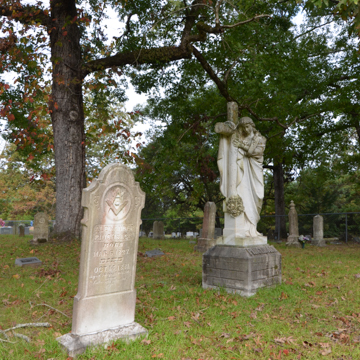Located in a remote area of northwest Dallas County, the cemetery is divided into two sections, one for whites and the other for blacks. The latter contains few stone headstones and lies outside the chain-link fence enclosing the well-kept grassy area reserved for whites. Common enough are the several homemade headstones of concrete or fieldstone with rough inscriptions made to resemble commercial markers. Several other items marking graves, however, apparently have African antecedents. These include broken fragments of ceramic drainage pipe, small irregular-shaped pieces of “rich pine” that resemble petrified wood and are sometimes propped within concrete blocks (one wood fragment was propped against an old flat iron); broken jars and, on one grave, broken ceramic pitchers and bowls aligned to show the length of the grave. In the book Afro-American Folk Art and Crafts (1983) edited by William Ferris, Robert Farris Thompson notes that West African peoples for hundreds of years have placed personal possessions, especially earthenware and small roughly shaped wooden figures, on the top of graves, noting, “The deposit of chinaware and other objects on the Afro-American grave is in contrast with the stark plots of grass which cover the graves of Americans of European descent.” Thompson relates an African American informant telling, “You put dishes and bottles and all the pretty pieces what they like on the grave. You always break these things.” Breaking the objects would break the chain of death in the family. Although such West African–related memorial items have been well-documented in cemeteries in the Southeast, this collection is Arkansas’s only known example.
You are here
Hampton Springs Cemetery
Late 19th century established. County Rd. 427, off County Rd. 426, south of AR 48, 4 miles east of Carthage
If SAH Archipedia has been useful to you, please consider supporting it.
SAH Archipedia tells the story of the United States through its buildings, landscapes, and cities. This freely available resource empowers the public with authoritative knowledge that deepens their understanding and appreciation of the built environment. But the Society of Architectural Historians, which created SAH Archipedia with University of Virginia Press, needs your support to maintain the high-caliber research, writing, photography, cartography, editing, design, and programming that make SAH Archipedia a trusted online resource available to all who value the history of place, heritage tourism, and learning.









